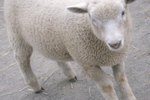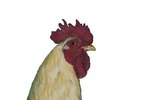
Shearing sheep, which means removing their wool with electric or manual clippers, is no easy task. It's hot, dirty and time consuming, but it's a necessity if you raise sheep. Most sheep breeds need to be sheared at least once a year, although some breeds have wool that grows faster and need shearing twice a year.
Why Shear?
The main purpose of shearing sheep is to make them more comfortable. Wool holds in heat, which makes it ideal for spinning into yarn used to make cold-weather clothes such as sweaters -- which is the secondary reason many sheep are sheared. But sheep can get overheated under all that wool in the summer. The wool keeps growing longer and thicker continuously, so every sheep must be sheared at least once a year to keep the wool from getting too uncomfortable for the sheep or becoming overly matted with dirt and grass. Even if you raise sheep for milk or cheese instead of wool trade, you must still shear them to keep them healthy.
Twice a Year
Most sheep do well with annual shearings, but some breeds grow wool faster and need to be sheared more often. Breeds such as Cotswolds, Icelandics and Lincolns have wool that can grow up to an inch per month, which means you shouldn't wait an entire year before removing the wool. If you're raising sheep for their wool, shearing twice a year gives you cleaner, fresher wool that's more desirable.
When to Shear
Most shepherds choose to shear their sheep in the spring to get the heavy wool off the sheep before the hot weather creeps in. Many ewes deliver lambs in the late spring, and shearing about a month before the lambs are due is easier on the moms than waiting until close to their due dates or after the births. Shearing a month prior to lambing lets your ewes get over the stress of shearing before the lambs come. It can also encourage them to eat more, which they need in their last few weeks of pregnancy. If you're shearing twice a year, shoot for early spring and the end of summer or early fall. Sheep need at least six weeks to grow enough wool to keep them warm in the winter. The second shearing might not yield as much wool as the spring shearing, but it means the spring wool will be newer and cleaner.
Crutching
Crutching is shearing just a couple of areas on the sheep, usually the sheep's rear end and between her hind legs. This is most common on females, but some shepherds crutch males to keep feces off the wool. For females, it helps keep them cleaner when they deliver lambs, and the lambs can find their mothers' udders easier without having to dig through wool. Crutching is only necessary in between shearings, such as for ewes who are delivering lambs in the winter instead of the spring.
References
Photo Credits
-
Jupiterimages/Photos.com/Getty Images




